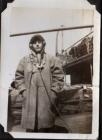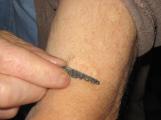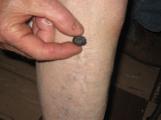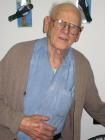1
In 1940, when HMS Jervis Bay sailed out of Halifax,, Nova Scotia for England. She was to be the lone escort of Convoy HX-84. The fourteen thousand ton Jervis Bay, a passenger vessel converted to an armed cruiser for convoy escort duty under command of an Irish Captain, Forgerty Fegan, was about to embark upon what was later considered one of the classic sea battles of the Second World War. The convoy of 38 vessels, unknowingly were sailing toward the Admiral Sheer, a modern heavily armed German Pocket Battleship. When the Sheer was spotted and action stations sounded, Captain Fogerty Fegan set up a smoke screen to cover the convoy as they followed his command to scatter. There was gunfire on both sides but the Bay's seven ancient 6 inch guns were no match for the Sheer's modern automated 11 inch guns. Though the Jervis Bay put up a valiant fight, it was all over in 22minutes and 22 seconds, Fegan wounded and bleeding, perservered to the end an action for which he was post-humously awarded the Victoria Cross. He and 244 crew members lost their lives in the affray. Arthur Taylor of St. John's was among the 65 Survivors.That night, Fogerty Fegan and his crew saved 33 ships from the attack.2
Arthur Taylor in Full Seagoing OutfitCirca 1940
St. John's Harbour, Newfoundland
 Credits:
Credits:Ruby Moores Thomas Collection
4
My name is Art Taylor I'm 85, I live on 133 Old Petty Harbour Road. I was 19 and we sailed from St. John's on the RMS Newfoundland that was a passenger boat at that time and we arrived in England in September 1940. I was in CHAM, that's the barracks. We were assigned after our training to the HMS Jervis Bay, that was in peacetime that was a passenger boat but during the war such a shortage of convoy escorts, a lot of merchant ships were converted into cruisers, they were mounted with 6 inch guns and they were escorting convoys from Halifax to Derry, Londonderry. The convoys assembled about 5 or 6 or about 10 miles out from St. John's and there were ships from the States and from Canada and Bermuda and the convoy assembled there and that was the rendezvous and then they set sail for England. But a lot of them didn't go straight across, to avoid the submarines, they went up north towards Norway and Sweden to evade the submarines, they didn't sail the same course every time so they went that way to evade the submarines.Now on November 5 this German Cruiser was sighted, the Sheer, they didn't know what it was at the time. So they spotted us first, they sent the signal then they opened fire. Now the Jervis Bay, Captain Fogerty Fegan, he challenged them to find out what boat it was and they replied with a salvo, that's a gun, he replied with the 11 inch gun and the second round they fired took off part of the bridge. Now his (Captain Fegan's) idea was to protect the convoy, that's all merchant ships were, that was their duty to protect the convoy. Now he knew when this thing fired they could see it from the bridge, they knew what they spotted was the Sheer, that was a German light cruiser so he (Captain Fegan) opened fire, well he (Captain Fogerty Fegan ), knew what he was up against because they had 11.5 inch guns and we had 6 so we were sitting ducks. So he (Captain Fegan) went in and before he went in he put up a smoke screen, and the smoke screen was to cover the convoy with black smoke and their orders was to go to the nearest port get the hell out of it. There was 47 ships or something like that in that convoy. We were only 14 knots and he was 32 so he was headed in towards this German Cruiser, he went in and kept on going in towards this German ship, The Sheer, light cruiser and then it was getting kinda dark in the evening. He fired till there were no guns left. She was on fire from head to stern. You had your lifebelts on and they were only what they called a Mae West a rubber tube they weren't like the modern things that they got today survival suits, just only an ordinary lifebelt like a youngster had to swim in. Anyway then when the ship she sank nose first, she went down bow first the stern was up in the air, that's the way she sank, then when the captain seen it was hopeless the guns were all out of commission, so he gave the orders to abandon ship but meanwhile he got a shot in the arm, there wasn't too much of his arm a piece of stuff struck and took away half of his arm, he went down with her but he kept on going in. The Germans sank four of the convoy. They had rafts put over and the rafts, all the life boats were afire, so they had those big rafts there, and they just threw them in the water and you got on them. Now the raft consisted of four oil drums boarded in but there was food and water and whatever way that fell in the water the food was up top. They got two rafts away, those wooden rafts and that's what we were clinging to. You had to keep moving you had a piece of board and had to keep awake otherwise you die with hypothermia. In November 5, 1940 she was about half way across. The survivors got on the raft, now we were picked up, it must be one in the morning, this Swedish ship he was supposed to go to the nearest port, that's what their orders were, but he came back after the hours of darkness and he said to the crew, "the Jervis Bay served our ship," so he said "the least we could do is go back and pick up survivors". I didn't know anything. I knew I was on the raft. I must have dozed off. I woke up in Campton Hospital in Halifax, and they operated and they took them pieces out of my leg and that, but the small stuff on you hands and your arms, they took them off with a brush, but the heavier pieces they had to operate for that you see, in the leg and the arm. When the guns fired there was a mess of shrapnel and pieces of shell went all over the boat and a lot of people were killed by the shrapnel and some were killed outright.
5
Shrapnel from Arthur Taylor's Arm Received During the Battle with the Admiral SheerJanuary 2008
St. John's, Newfoundland, Canada
 Credits:
Credits:Arthur Taylor
Jacquey Ryan
6
Shrapnel Removed in 1940 from Arthur Taylor's LegJanuary 2008
St. John's, Newfoundland, Canada
 Credits:
Credits:Arthur Taylor
Jacquey Ryan
